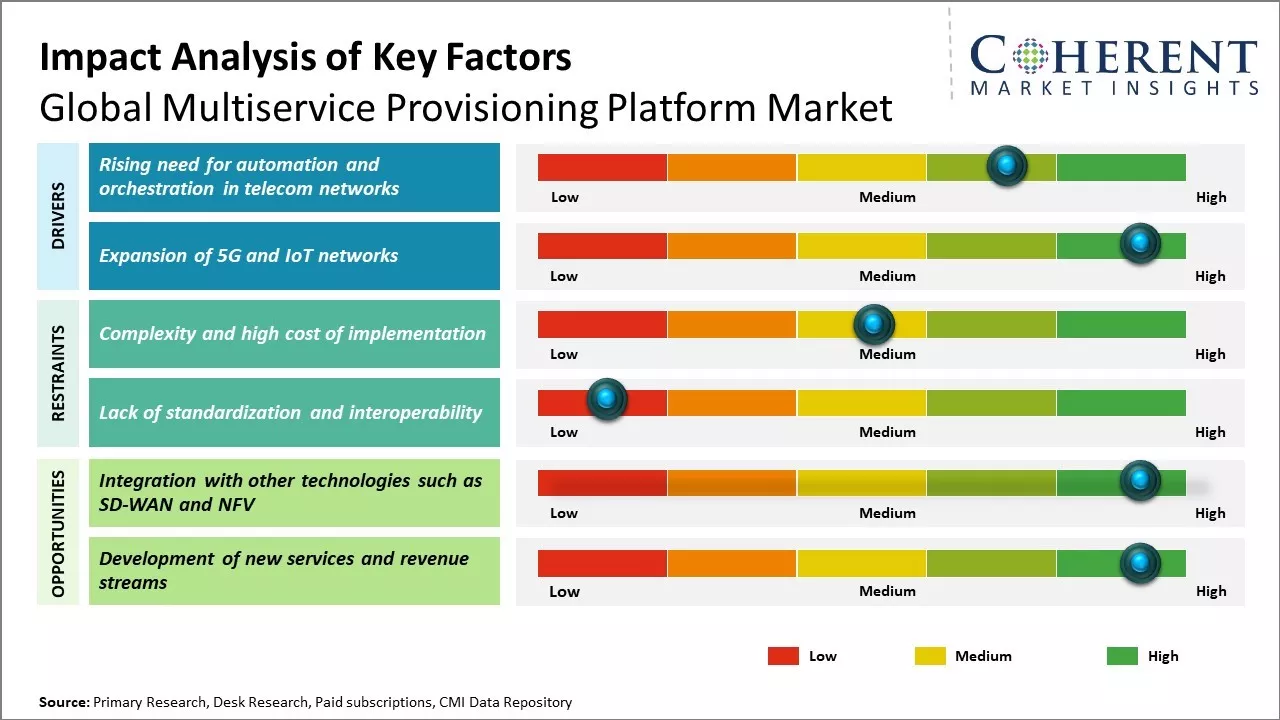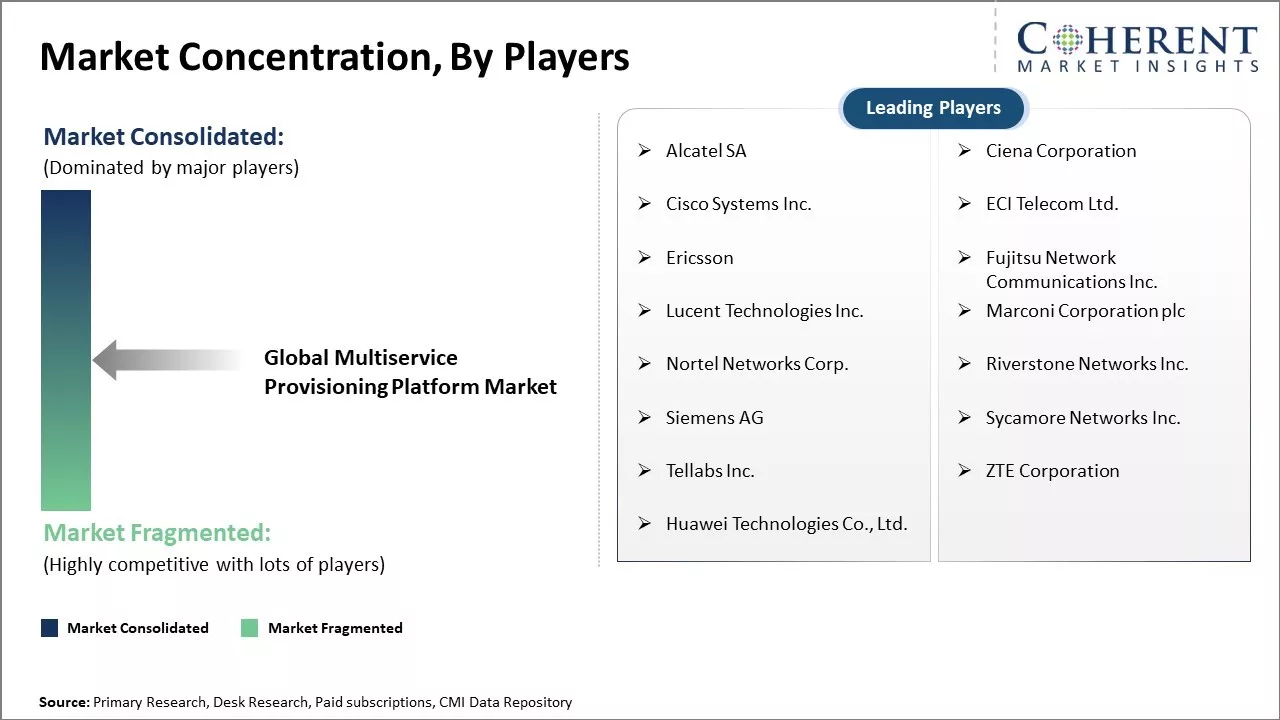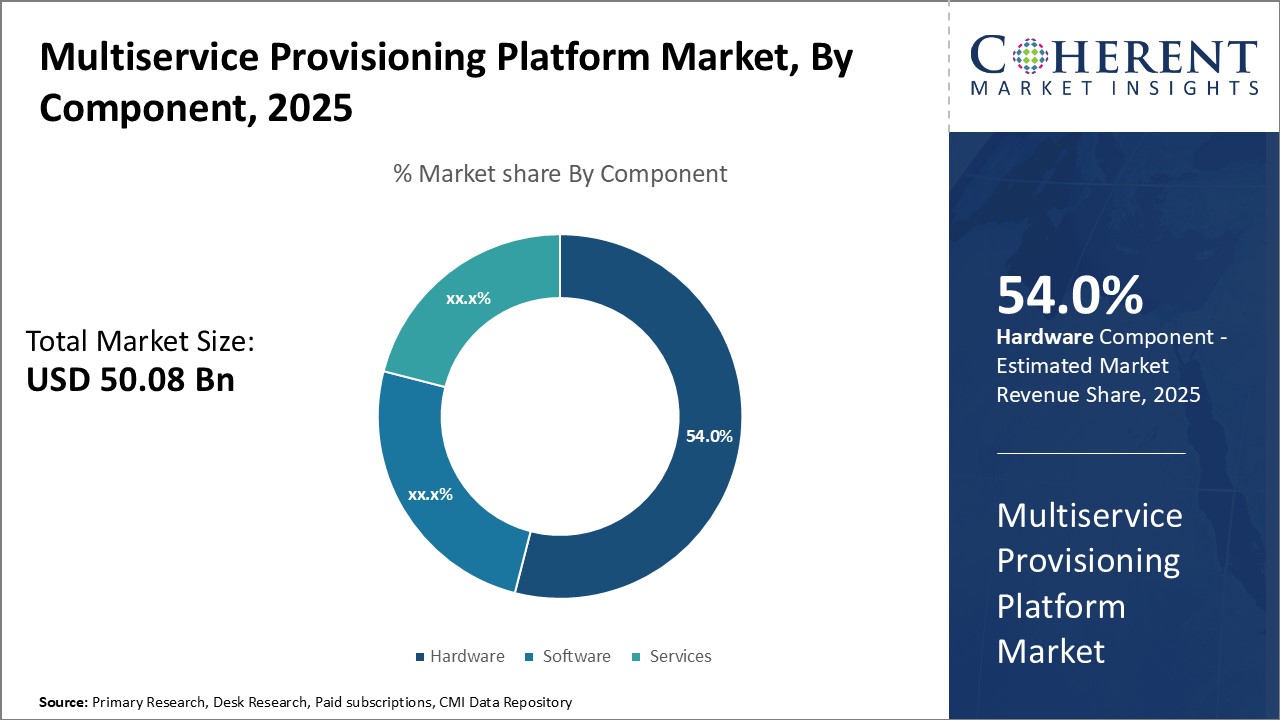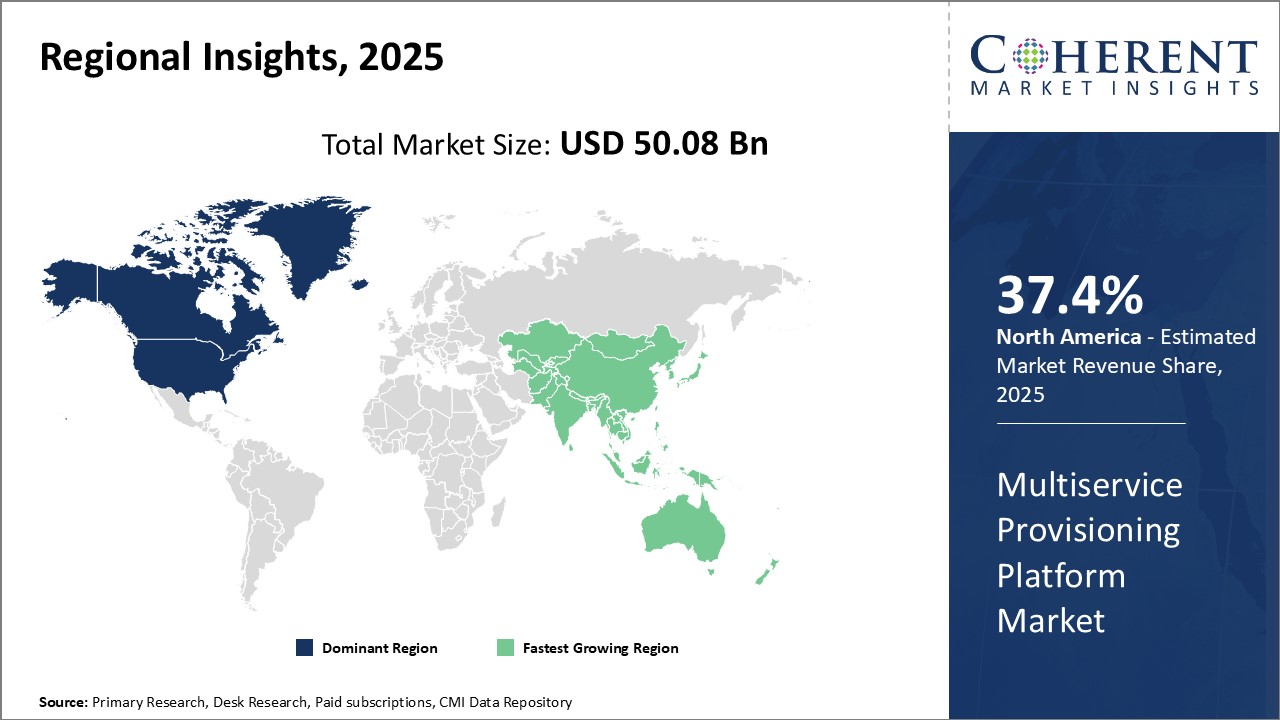Multiservice Provisioning Platform Market Size and Trends
Global multiservice provisioning platform market is estimated to be valued at USD 50.08 Bn in 2025 and is expected to reach USD 69.12 Bn by 2032, exhibiting a compound annual growth rate (CAGR) of 4.7% from 2025 to 2032.

Discover market dynamics shaping the industry: Download Free Sample
The multiservice provisioning platform provides several advantages like centralized credential management, simplified operations, and cost reduction which is driving its adoption across industries. Increasing demand for centralized authentication systems and unified access to diverse IT infrastructure from enterprises is driving the adoption of multiservice provisioning platforms. These platforms offer benefits like increased productivity, simplified operations, and reduced IT expenses which is fueling their demand.
Market Driver - Rising need for automation and orchestration in telecom networks
As telecom networks continue to grow in complexity with the rise of 5G, Internet of Things (IoT), and other advanced technologies, maintaining and managing these complex networks is becoming an increasingly difficult task for communication service providers (CSPs).
With a multi-service provisioning platform, CSPs can automate both routine and complex workflows across various network technologies and domains. It helps standardize processes, eliminates manual touches, and provides visibility across different systems and protocols. Outdated and fragmented systems can be consolidated and streamlined. Now network resources like hardware, software, and services can be provisioned automatically according to the requirements specified through the platform.
As networks continually evolve and new segments like IoT/edge/cloud emerge, the ability to support diverse technologies on a single platform becomes even more crucial. It allows CSPs to roll out new services at greater speed while reducing integration risks. Automation also results in greater operational efficiencies which can help CSPs meet their financial goals. Considering these benefits, it is increasingly important for CSPs to deploy a multi-service provisioning platform that can streamline network operations, make them agile to support future technologies and bring the network under a single unified control. This helps them better manage network complexity and compete effectively in today's cut-throat telecom environment.
Market Concentration and Competitive Landscape

Get actionable strategies to beat competition: Download Free Sample
Expansion of 5G and IoT networks
The rise of 5G technology and exponential growth of IoT present a massive business opportunity for CSPs but also introduce several challenges related to network management and operations. 5G networks are far more complex multi-dimensional systems compared to previous generations. They rely on a variety of new technologies and network domains - from enhanced mobile broadband to mission critical applications. Similarly, IoT connections are also diversifying across a broad range of use cases requiring tailored solutions. Managing these large-scale heterogeneous networks with traditional tools is near impossible for CSPs.
A multi-service provisioning platform creates the foundation required to build and manage next-generation 5G and IoT networks at scale. With its unified orchestration capabilities, CSPs can automate processes across different domains and flexibly provision hardware and software resources according to dynamic requirements. As networks expand and technologies advance rapidly, the platform provides a single point of control as well as integration for diverse systems. This helps CSPs roll out new services and capacities in a timely and cost-efficient manner.
In June 2023, Nokia, a global leader in telecommunications and networking technology, launched a new multiservice provisioning platform that supports 5G services. This innovative platform enables operators to efficiently manage and provision both legacy and next-generation services from a single interface, enhancing their operational capabilities in a rapidly evolving market.
Key Takeaways from Analyst:
The global multiservice provisioning platform market is expected to witness significant growth over the forecast period driven by the rising demand for converged networking services. Telecom operators are increasingly looking to offer high-speed internet access, IPTV, VoIP, and other data services over a single network in order to improve operational efficiencies and provide enhanced customer experience. This is likely to drive the adoption of multiservice provisioning platforms across both developed and developing regions. However, heavy investments required for deployment and upgrades pose a major challenge to market growth.
The North America region, with the huge consumer base and increasing penetration of broadband and smart devices, dominates current demand and offers the most promising growth opportunities. Meanwhile, countries in Asia Pacific also expected to contribute significantly as network operator’s aim for service convergence to address competitive pressures. On the other hand, emerging economies in Latin America, Middle East, and Africa offer potential for future expansion as telecom markets continue to evolve rapidly.
In terms of technology, software-defined networking based multiservice platforms are witnessing higher popularity compared to traditional hardware-centric approaches. This is because SDN enables faster service rollouts, scalability, and network programmability which are well-aligned with operators' needs for agility.
Market Challenge - Complexity and high cost of implementation
One of the key challenges that the global multiservice provisioning platform market is facing is the complexity and high cost involved in the implementation of these platforms. Integrating different network services into a common architecture is a complex task which requires coordination between multiple teams. Service providers need to virtualize and consolidate various discrete technologies which increases the complexity of network operations. This implementation process requires specialized skills and expertise which increases the cost of hiring resources. Integrating legacy systems that have been running in silos also poses technical challenges. Additionally, testing and validating such complex platforms before commercial deployment involves significant expenditure. The upgradation of the existing infrastructure to accommodate new features also contributes to high capital expenditures. While multiservice provisioning brings convergence benefits, the complex integration of various components is a hindrance for many smaller carriers to adopt this technology.
Opportunity: Integration with other technologies such as SD-WAN and NFV
The global multiservice provisioning platform market has a major opportunity in further integrating these platforms with emerging technologies such as SD-WAN and network functions virtualization. As enterprises increasingly adopt cloud-based applications and flexible working models, they demand network connectivity that can offer consistent experience across multiple sites. Integration of multiservice provisioning platforms with SD-WAN capabilities allows providers to dynamically steer traffic based on application requirements. This helps deliver superior quality of experience for real-time collaboration tools. Furthermore, virtualizing more network functions through NFV integration would help optimize resource utilization and enable faster service provisioning. Advanced analytics and assurance functions could also be leveraged through the platform to improve performance monitoring. Such integrations present a significant opportunity for carriers to expand their unified communications and connectivity portfolio and be well-positioned to cater to the high growth enterprise market.

Discover high revenue pocket segments and roadmap to it: Download Free Sample
Insights By Component - Hardware Segment Propels Growth: The Cornerstone of Contemporary Multiservice Platforms
In terms of component, the hardware segment is estimated to hold 54.0% share of the market in 2025 owing to its pivotal role in enabling the core functionality of modern multiservice provisioning platforms. Dedicated servers, switches, routers, and other hardware infrastructure form the backbone that allows platforms to efficiently process and route massive amounts of network traffic and data in real time. Compared to software and services, hardware sees fewer opportunities for substitution and has a longer replacement cycle, ensuring steady demand. In addition, hardware manufacturers frequently introduce new performance-boosting technologies like quicker processors, larger storage capacities, and enhanced connectivity options that spur regular hardware refreshes across various industry verticals. Service providers in particular rely on robust, high-capacity hardware to seamlessly deliver bandwidth-intensive applications and multimedia services to business and residential customers. As network capabilities and usage continue growing exponentially worldwide, hardware will remain a mission-critical component for multiservice platforms.
Insights By Deployment - On-premises Segment Leads due to Foundational Control for Critical Infrastructure Prevails
In terms of deployment, the on-premises segment is estimated to hold 39.4% share of the market in 2025 due to the foundational importance of internal infrastructure control for many organizations. Telecommunications carriers and other service providers handling sensitive and bandwidth-intensive workloads require maximum control over network architecture, security protocols, and quality of service for mission-critical systems. On-premises hardware and software enable full customization and optimization of these environments according to internal technical needs and regulatory requirements. Private clouds also address concerns around data ownership, network latency for real-time services, and cloud vendor lock-in which make the on-premises model more appealing for managing core telecommunications systems. While hybrid and public cloud options gain prominence, on-premises deployment will remain the default for telecom infrastructures at the heart of modern connectivity.
Insights By End User - Telecommunications Service Providers Segment Dominated due to Establishing the Foundation of Connectivity
In terms of end user, the telecommunications service providers segment is estimated to dominate the market revenue share with 56.6% in 2025 owing to their unique need to manage vast physical networks and rapidly develop virtual offerings. As the core providers of connectivity infrastructure, telecom suppliers require robust multiservice platforms to seamlessly integrate legacy and next-gen networks, efficiently provision new services, and deliver quality experiences. Both international carriers and regional wireless/wireline operators leverage these platforms to automate operations, activate customers, and monetize 5G/IoT infrastructure investments. Moreover, consolidating service lifecycle management onto a single platform allows telecoms to streamline traditionally siloed functions and optimize network resource usage. As digital transformation increases connectivity demands, telecom suppliers will continue pioneering new services while relying on advanced provisioning platforms as the control center orchestrating vast telecommunications networks.
Regional Insights

Need a Different Region or Segment? Download Free Sample
North America currently dominates the global multiservice provisioning platform market with an estimated share of 37.4% in 2025. The region has a large and well-established telecommunications industry with major companies like AT&T, Verizon, and CenturyLink offering advanced network infrastructure across the region. There is strong demand for multiservice provisioning solutions from enterprises looking to consolidate their networking and communications needs onto a single platform. In addition, North America sees significant investment in 5G network rollouts which require platforms that can provision and deliver new services at scale. The focus on digital transformation among businesses further drives the need for modernization of service delivery channels.
Asia Pacific is projected to be the fastest growing regional market over the coming years. Rapid economic expansion and infrastructure development across developing countries like India and Indonesia are bringing more enterprises online which need provisioning solutions. The young demographics and growing spending power of consumers are also prompting companies to explore new digital business models and monetization of services. This acts as a growth lever for multiservice provisioning platforms that help launch and market innovations to customers seamlessly.
The mature markets of North America and Europe currently account for over 60.5% of the global revenue on the back of large-scale deployments by communications giants. However, Asia Pacific is emerging as an attractive market driven by the digital transformation agenda of both regional companies as well as global enterprises expanding operations in Asia. The focus on building smart cities and fueling e-commerce adoption will further strengthen the demand for tools facilitating agile service provisioning and optimized consumer experiences.
Market Report Scope
Multiservice Provisioning Platform Market Report Coverage
| Report Coverage | Details | ||
|---|---|---|---|
| Base Year: | 2024 | Market Size in 2025: | USD 50.08 Bn |
| Historical Data for: | 2020 To 2024 | Forecast Period: | 2025 To 2032 |
| Forecast Period 2025 to 2032 CAGR: | 4.7% | 2032 Value Projection: | USD 69.12 Bn |
| Geographies covered: |
|
||
| Segments covered: |
|
||
| Companies covered: |
Alcatel SA, Ciena Corporation, Cisco Systems Inc., ECI Telecom Ltd., Ericsson, Fujitsu Network Communications Inc., Lucent Technologies Inc., Marconi Corporation plc, Nortel Networks Corp., Riverstone Networks Inc., Siemens AG, Sycamore Networks Inc., Tellabs Inc., ZTE Corporation, and Huawei Technologies Co., Ltd. |
||
| Growth Drivers: |
|
||
| Restraints & Challenges: |
|
||
Uncover macros and micros vetted on 75+ parameters: Get instant access to report
Multiservice Provisioning Platform Industry News
- In July 2023, Juniper Networks, a global leader in AI-driven networking solutions, announced new AI-powered provisioning tools that integrate with their multiservice platform. These innovative tools are designed to optimize network performance and reduce operational costs for service providers, enhancing their ability to deliver efficient and reliable services.
- In April 2023, Huawei Technologies Co., Ltd., a global leader in ICT solutions and telecommunications equipment, introduced a cloud-native multiservice provisioning platform designed to support a wide range of applications and services. This platform aims to enhance flexibility and scalability for service providers, enabling them to efficiently meet the demands of a dynamic market.
- In March 2021, TelemaxX Telekommunikation GmbH, a prominent data center provider based in Karlsruhe, Germany, specializing in data storage and management services, deployed products from Ciena’s packet networking portfolio to facilitate the smooth rollout of Ethernet Business Services (EBS). This initiative aimed to enhance TelemaxX's capabilities in delivering efficient and secure telecommunications solutions to its clients.
*Definition: The Global Multiservice Provisioning Platform Market is a marketplace focused on delivery of network and IT services across multiple domains. It provides a converged platform that enables telecom and cloud service providers too quickly and cost-effectively create, deliver, manage and assure customized digital services around the world. The multiservice provisioning platform streamlines operations, improves time-to-market for new services, and enhances the customer experience.
Market Segmentation
- Component Insights (Revenue, USD Bn, 2020 - 2032)
- Hardware
- Software
- Services
- Deployment Insights (Revenue, USD Bn, 2020 - 2032)
- On-premises
- Cloud-based
- End User Insights (Revenue, USD Bn, 2020 - 2032)
- Telecommunications Service Providers
- Internet Service Providers (ISPs)
- Enterprises
- Others
- Regional Insights (Revenue, USD Bn, 2020 - 2032)
- North America
- U.S.
- Canada
- Latin America
- Brazil
- Argentina
- Mexico
- Rest of Latin America
- Europe
- Germany
- U.K.
- Spain
- France
- Italy
- Russia
- Rest of Europe
- Asia Pacific
- China
- India
- Japan
- Australia
- South Korea
- ASEAN
- Rest of Asia Pacific
- Middle East
- GCC Countries
- Israel
- Rest of Middle East
- Africa
- South Africa
- North Africa
- Central Africa
- North America
- Key Players Insights
- Alcatel SA
- Ciena Corporation
- Cisco Systems Inc.
- ECI Telecom Ltd.
- Ericsson
- Fujitsu Network Communications Inc.
- Lucent Technologies Inc.
- Marconi Corporation plc
- Nortel Networks Corp.
- Riverstone Networks Inc.
- Siemens AG
- Sycamore Networks Inc.
- Tellabs Inc.
- ZTE Corporation
- Huawei Technologies Co., Ltd.
Share
Share
About Author
Monica Shevgan has 9+ years of experience in market research and business consulting driving client-centric product delivery of the Information and Communication Technology (ICT) team, enhancing client experiences, and shaping business strategy for optimal outcomes. Passionate about client success.
Missing comfort of reading report in your local language? Find your preferred language :
Transform your Strategy with Exclusive Trending Reports :
Frequently Asked Questions
EXISTING CLIENTELE
Joining thousands of companies around the world committed to making the Excellent Business Solutions.
View All Our Clients
